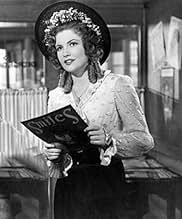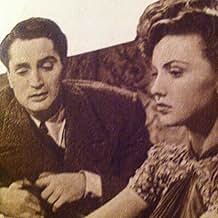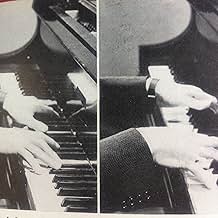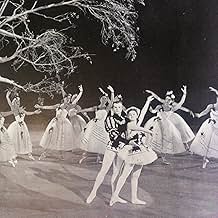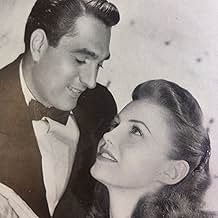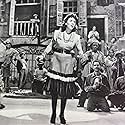IMDb-BEWERTUNG
7,0/10
1881
IHRE BEWERTUNG
Füge eine Handlung in deiner Sprache hinzuGeorge Gershwin is a driven composer whose need to succeed destroys his relationship with singer Julie Adams and socialite Christine Gilbert.George Gershwin is a driven composer whose need to succeed destroys his relationship with singer Julie Adams and socialite Christine Gilbert.George Gershwin is a driven composer whose need to succeed destroys his relationship with singer Julie Adams and socialite Christine Gilbert.
- Für 2 Oscars nominiert
- 2 Gewinne & 4 Nominierungen insgesamt
Albert Bassermann
- Prof. Franck
- (as Albert Basserman)
Rosemary DeCamp
- Rose Gershwin
- (as Rosemary De Camp)
Empfohlene Bewertungen
The "Gershwin Years" were very exciting times, and the life and career of George --and his brother, Ira--are well captured in this memorable classic, "Rhapsody in Blue." Tackling this subject was a difficult one, and it manages to reveal the composer's exuberance for his art, his trials and his successes. Robert Alda is a perfect choice for George; others making fine contributions are Oscar Levant and Alexis Smith. A host of great artists, many playing themselves round out a star-studded cast. A wonderful selection of Gershwin's works are represented, some in near-complete versions. This is one of the most successful of classical composer bios ever brought to the screen. It is a cherished part of my video library, and I thoroughly enjoy watching and listening to this recreation of the life, times, and music of one of American's great composers.
Thank God the film-makers trusted in the power of Gershwin's music to allow almost complete versions of the title composition, and "An American in Paris" to be included in the film - as well as many complete songs. All the music is superbly orchestrated and the songs sung beautifully by a wide variety of artists, many of whom were really the first artists to sing them. The film is excellently directed and photographed, with musical scenes well realised visually. The montage of Gershwin wandering about Paris as we hear "An American In Paris" is excellent - and the use of lights and shadows to film the orchestra playing "Rhapsody in Blue" is magnificent - would that contemporary films of orchestras were this imaginative.
Yes I know it is largely fiction - but so what? This is a tribute, not a documentary. And Alda is fine in the lead, backed by an excellent supporting cast. I loved this film from start to finish.
Yes I know it is largely fiction - but so what? This is a tribute, not a documentary. And Alda is fine in the lead, backed by an excellent supporting cast. I loved this film from start to finish.
Of all our famous Tin Pan Alley composers George Gershwin alone managed to bridge that gap between the old masters of Europe and our own American musical traditions. I've always had a particular affinity for his music, maybe because he and I share the same birthday, 49 years apart though. He did so much in his life of 38 years and left so much unwritten and unsung it's impossible to comprehend all this beauty could have come from the mind of one man.
Rhapsody In Blue is no better or worse than some of the other Hollywood biographies of our composers. The idea was to make a musical picture and story is always sacrificed, especially in the accuracy department. Joan Leslie and Alexis Smith play a compilation of characters of many women involved in George Gershwin's life. It is true however that Gershwin sacrificed all for his art. He wanted to attain heights that no American composer ever did and he succeeded.
There is also the problem of contracts and copyrights in making these kind of films. Certain Gershwin standards you won't hear because either Warner Brothers didn't have the rights or Jack Warner was spending way too much money for the Gershwin songs to begin with.
Al Jolson, Paul Whiteman, and Oscar Levant all appear as themselves in this, the story of Gershwin could not be told without them. Jolson introduced Gershwin's first hit song of Swanee, he interpolated it in one of his shows which he always did. Paul Whiteman, the King of Jazz, took that crown with his concert at Aeolian Hall of Rhapsody In Blue from whence this film gets its title. It maybe the most well known instrumental piece of music by an American composer ever.
And certainly no life of Gershwin could have even been filmed without Oscar Levant whose friendship and abiding affection for George Gershwin was well known. Levant's wit was devastating, even upon himself and his friend George. But he worshiped at the altar of that music.
But a real treat for me was Anne Brown, the original Bess from Porgy and Bess singing Summertime. That alone is worth seeing this film.
Hazel Scott, singer, jazz pianist, and outspoken civil rights advocate plays a Josephine Baker type role and does several Gershwin numbers while he's in Paris. The film sadly makes no mention of Fred Astaire or Gertrude Lawrence both of whom are very important in George Gershwin's career. And it would have been nice to see Victor Moore playing Throttlebottom from Of Thee I Sing which got a one line mention about it winning a Pulitzer Prize and that was it.
Robert Alda plays the title role and he did get good reviews and to the limited extent the script gave the character, he does capture the essence of the driven Gershwin. Stardom in Hollywood would elude Alda however, he'd have to wait for Broadway and Guys And Dolls.
I was sorry to see the role of Ira Gershwin by Herbert Rudley given such a short shrift. Ira was an interesting man in his own right. He wrote lyrics with several other name composers both before and after his brother's demise. In fact he wrote with others specifically to establish his own credentials so no one would think he was just riding on brother George's coattails.
Gershwin's one man who could use a new biographical film. Maybe we can get a better idea of his life, have his songs done in proper chronological order and see him from another century's perspective.
Until then Rhapsody In Blue will give you a general idea.
Rhapsody In Blue is no better or worse than some of the other Hollywood biographies of our composers. The idea was to make a musical picture and story is always sacrificed, especially in the accuracy department. Joan Leslie and Alexis Smith play a compilation of characters of many women involved in George Gershwin's life. It is true however that Gershwin sacrificed all for his art. He wanted to attain heights that no American composer ever did and he succeeded.
There is also the problem of contracts and copyrights in making these kind of films. Certain Gershwin standards you won't hear because either Warner Brothers didn't have the rights or Jack Warner was spending way too much money for the Gershwin songs to begin with.
Al Jolson, Paul Whiteman, and Oscar Levant all appear as themselves in this, the story of Gershwin could not be told without them. Jolson introduced Gershwin's first hit song of Swanee, he interpolated it in one of his shows which he always did. Paul Whiteman, the King of Jazz, took that crown with his concert at Aeolian Hall of Rhapsody In Blue from whence this film gets its title. It maybe the most well known instrumental piece of music by an American composer ever.
And certainly no life of Gershwin could have even been filmed without Oscar Levant whose friendship and abiding affection for George Gershwin was well known. Levant's wit was devastating, even upon himself and his friend George. But he worshiped at the altar of that music.
But a real treat for me was Anne Brown, the original Bess from Porgy and Bess singing Summertime. That alone is worth seeing this film.
Hazel Scott, singer, jazz pianist, and outspoken civil rights advocate plays a Josephine Baker type role and does several Gershwin numbers while he's in Paris. The film sadly makes no mention of Fred Astaire or Gertrude Lawrence both of whom are very important in George Gershwin's career. And it would have been nice to see Victor Moore playing Throttlebottom from Of Thee I Sing which got a one line mention about it winning a Pulitzer Prize and that was it.
Robert Alda plays the title role and he did get good reviews and to the limited extent the script gave the character, he does capture the essence of the driven Gershwin. Stardom in Hollywood would elude Alda however, he'd have to wait for Broadway and Guys And Dolls.
I was sorry to see the role of Ira Gershwin by Herbert Rudley given such a short shrift. Ira was an interesting man in his own right. He wrote lyrics with several other name composers both before and after his brother's demise. In fact he wrote with others specifically to establish his own credentials so no one would think he was just riding on brother George's coattails.
Gershwin's one man who could use a new biographical film. Maybe we can get a better idea of his life, have his songs done in proper chronological order and see him from another century's perspective.
Until then Rhapsody In Blue will give you a general idea.
As with most Hollywood biopics (particularly back in the 1930s, 40s, and 50s), this account of the life of George Gershwin is somewhat fictionalized. As just one example, in real life he also had two sisters, who are not even mentioned in the film. And, the romantic angles here (with two women) apparently are fictionalized. But, so what. This is a surprisingly entertaining film, and a number of Gershwin's pieces are faithfully executed, including "Rhapsody In Blue". I watched this quite a long time ago and remembered it as one of the better movie biopics...plus, I rather like Gershwin's music. I think I liked this film better the second time around.
Robert Alda is fine in the lead role, as are others in supporting roles, including Charles Coburn as a mentor on the pop side of things. Particularly interesting are the many "cameo" appearances by real associates of Gershwin -- Al Jolson ("Swanee"; although so clearly too old to play a young Jolson!), George White (of the famous "Scandals"), and Paul Whiteman. Supporting players are good here -- Joan Leslie, Alexis Smith, especially Albert Bassermann, Rosemary DeCamp, Oscar Levant, and Herbert Rudley (as Ira Gershwin).
At just over 2:20, it's a long movie, but that length allows so much of the Gershwin music to be played. I can't help but compare this to the Cole Porter biopic starring my favorite actor -- Cary Grant; but this is so much better a film. A good movie worth watching at least once for the acting and to revel in the music.
Robert Alda is fine in the lead role, as are others in supporting roles, including Charles Coburn as a mentor on the pop side of things. Particularly interesting are the many "cameo" appearances by real associates of Gershwin -- Al Jolson ("Swanee"; although so clearly too old to play a young Jolson!), George White (of the famous "Scandals"), and Paul Whiteman. Supporting players are good here -- Joan Leslie, Alexis Smith, especially Albert Bassermann, Rosemary DeCamp, Oscar Levant, and Herbert Rudley (as Ira Gershwin).
At just over 2:20, it's a long movie, but that length allows so much of the Gershwin music to be played. I can't help but compare this to the Cole Porter biopic starring my favorite actor -- Cary Grant; but this is so much better a film. A good movie worth watching at least once for the acting and to revel in the music.
This film presents many Gershwin tunes in great fashion with several great settings and great production numbers. Yes, it's unfortunate that the story line is so heavily fictionalized and even misleading. But, the sets are honest to the periods covered, several sequences are very tastefully done and fun, the show excerpts are good, and did I mention the music? As several other commentators have indicated, the music is faithfully recreated in long segments that bring you much or all of the tune.
If you come to this film to hear some wonderful Gershwin performed by some great artists staged with a lot of character and splash (my favorite set is Hazel Scott's Paris show), you won't be disappointed. The story line is simply a convenient string to tie together the thread of music.
If you come to this film to hear some wonderful Gershwin performed by some great artists staged with a lot of character and splash (my favorite set is Hazel Scott's Paris show), you won't be disappointed. The story line is simply a convenient string to tie together the thread of music.
Wusstest du schon
- WissenswertesChico Marx sued Warner Bros for $200,000 for damages and "payment owed for services rendered." Marx alleged that the filmmakers used his name many times in the film. Studio officials admitted that Marx's name had been used in the film, but were unclear about what services the comedian had rendered. The parties settled for $10,000.
- PatzerChico Marx is referred to early in the film. Gershwin mispronounces the name as "CHEE-ko", which generally continues to this day. Chico's name is correctly pronounced as "CHICK-o".
- Zitate
Oscar Levant: Tell me something, George... if you had it to do all over again, would you still fall in love with yourself?
- VerbindungenEdited into The Story of Will Rogers (1952)
- SoundtracksEmbraceable You
(uncredited)
Music by George Gershwin
Lyrics by Ira Gershwin
Sung by Joan Leslie (dubbed by Sally Sweetland)
Top-Auswahl
Melde dich zum Bewerten an und greife auf die Watchlist für personalisierte Empfehlungen zu.
- How long is Rhapsody in Blue?Powered by Alexa
Details
- Erscheinungsdatum
- Herkunftsland
- Sprache
- Auch bekannt als
- Rhapsody in Blue
- Drehorte
- Produktionsfirma
- Weitere beteiligte Unternehmen bei IMDbPro anzeigen
- Laufzeit
- 2 Std. 15 Min.(135 min)
- Farbe
- Seitenverhältnis
- 1.37 : 1
Zu dieser Seite beitragen
Bearbeitung vorschlagen oder fehlenden Inhalt hinzufügen


